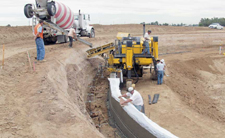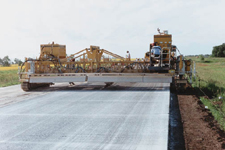by Diana Barnum
Correspondent

The process of slipforming concrete is impressive. Under good working
conditions, a crew can slipform 1,000 feet of imprinted barrier wall right
in the middle of traffic in one day. Actually most interstate is
slipformed, according to Jim George, manager of field engineering for
Complete General Construction in Columbus, Ohio.
“You just dump
concrete in a slipform machine (hopper); it augers it down into shape and
spits out mold,” said George.
Complete General is currently building
barrier walls and curbing in Cincinnati. And Gomaco is their equipment of
choice.
Two of the most popular slipform Gomaco machines in the Midwest
region are the Commander III and the GT3600. Tri Mor Corporation, a
concrete paving company in northeastern Ohio, purchased both of these
machine from The McLean Company in Columbus for their current slipform
jobs involving curb and gutter work and paving in the Euclid, Ohio
area.
The Commander III boasts a 140 hp, 2,100 rpm Cummins turbocharged
diesel engine. One standard curb and gutter mold up to 36” wide is
included, with optional molds available like a monolithic sidewalk curb
and gutter, barrier, parapet and irrigation canal.
The hydraulically
powered charging conveyor is reversible with a charging hopper. And the
hydraulically powered mount controls the conveyor slope, yielding pivot
mounting for height adjustment or swing, allowing hopper clearance and
front/side positioning.
The GT3600 features a 92 hp, 2,100 rpm 4BT3.9
Cummins turbocharged diesel engine. Its standard curb and gutter mold
measures up to 24” wide and will slipform a two-foot radius ribbon curb.
This machine has a drawbar and hold-down assembly with a 12” hydraulic
vertical adjustment cable of adjusting up to 18” with 6” manual vertical
adjustment. Sideshift distance is 48” maximum. A variable belt speed up to
220 fpm and four staggered Rhino Hyde Blades independently mounted on
spring steel rods are standard design for the charging conveyor. The
hopper is designed for more concrete capacity, allowing an operator to
slipform a complete radius without waiting for concrete
delivery.
Whitetopping
Another impressive process is overlaying
ultra-thin whitetopping (UTW) on existing asphalt. A 3- to 4-inch minimum
overlay poured in the morning can be driven on that evening.
“Whitetopping is for high-stress areas,” said Jim Barnhart, engineer
for the Ohio Ready Mix Association in Columbus. “It’s for heavy traffic
areas - upgrades for trucks, bus stops, stop lights and stop signs. But
you have to have a good stable base underneath the asphalt.”

Repairs are usually full-depth replacement. A demonstration by the
Innovative Pavement Research Foundation in Falls Church, Virginia, details
the repair process that is similar to full-depth repair of traditional
concrete pavement, except that no dowel bars or load transfer devices are
necessary. The steps are:
* Identify and mark slabs that need
removed.
* Saw cut panels to full depth with a diamond blade saw.
*
Remove panels with jackhammers or a Bobcat. Use caution - don’t damage
adjacent panels.
* Prepare the area by removing loose materials and
cleaning asphalt surface by blasting (air/sand).
* Place new concrete
directly from the ready mix truck.
* Consolidate concrete with a
handheld vibrator, finishing with a straight edge or vibratory screed to
meet grading specs. And texture the overlay to blend in with surrounding
areas.
* Apply curing compound after water sheen is gone.
* Cover
with insulating blanket if temperature falls below 60 degrees F within
eight hours of placement and traffic is expected.
* Saw joints,
aligning with existing ones.
* Cure concrete with membrane-forming
compound.
Add some operator tips from Barnhart to the mixture, too.
Steel or polyethylene fibers in the concrete mixture help control
shrinkage and cracking. And cut joints fairly close together, 3’ to 4’
spacing, like a rigid mattress.
What are the advantages of
whitetopping?
Less maintenance is required. And there is no rutting or
shoving, especially at intersections where trucks frequently turn.
Whitetopping is more durable than asphalt, although a little more costly.
And additives like accelerators and fly ash make for quick drying and same
day traffic.
For more information about concrete operations performed
in the middle of traffic, contact Complete General Construction at 1221 E.
Fifth Ave., Columbus, Ohio 43219. Call: (614) 258-9515, or fax inquiries
to: (614) 258-5398. Write to the Ohio Ready Mix Concrete Association at
P.O. Box 29190, Columbus, Ohio 43229-0190. Call: (614) 891-0210, or fax
inquiries to: (614) 891-2675. |